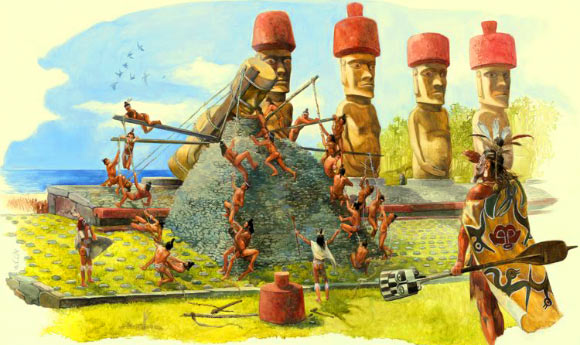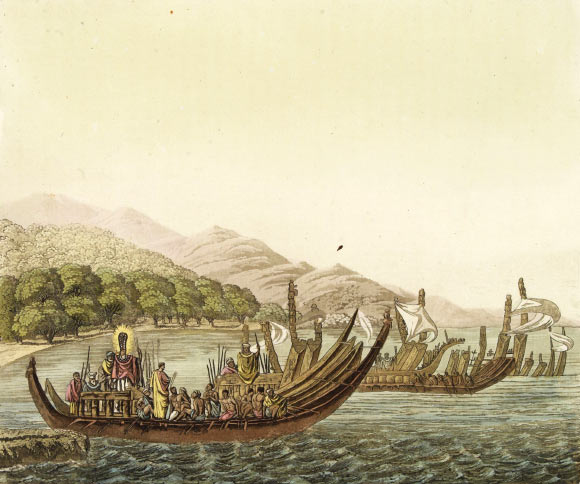Genomes of Ancient Easter Islanders Reveal Resilience and Pre-European Contacts with Americas

Easter Island, also known as Rapa Nui, is one of the most isolated inhabited places in the world. It has captured the imagination of many owing to its archaeological record, which includes megalithic statues. Two prominent contentions have arisen from the extensive study of the island. First, its history has been presented as a warning tale of resource overexploitation that would have culminated in a major population collapse — the ‘ecocide’ theory. Second, the possibility of trans-Pacific voyages to the Americas pre-dating European contact is still debated. To address these questions, a team of scientists from the Globe Institute and elsewhere sequenced and analyzed the genomes of 15 Rapanui individuals who lived between 1670 and 1950.

Rapanui people. Image credit: © Santiago Caruso.
Rapa Nui is one of the most isolated inhabited places in the world.
Located in the Pacific, on the easternmost tip of the Polynesian Triangle, it lies 3,700 km west of South America and more than 1,900 km east of the closest inhabited island.
Despite the remoteness of Rapa Nui, archaeological and genetic evidence shows that Polynesian peoples from the west had already reached the island about 1250 CE.
The following five centuries saw the Rapanui, the inhabitants of Rapa Nui, develop a culture characterized by iconic megalithic statues (moai) and monumental stone platforms (ahu).
Owing to the isolation of Rapa Nui, Europeans reached the island only in 1722 CE.
Over the years, European visitors had a devastating impact on the Rapanui as they killed local inhabitants and introduced deadly pathogens that the islanders had not been exposed to before.
Furthermore, in the 1860s, Peruvian slave raiders kidnapped a third of the population, and only a few were repatriated after international condemnation of the slaving practices.
Subsequently, a smallpox outbreak decimated the Rapanui population and it fell to an estimated 110 individuals.
“While it is well established that the environment of Rapa Nui was affected by anthropogenic activity, such as deforestation, we did not know if or how these changes led to a population collapse,” said Dr. Anna-Sapfo Malaspinas, a researcher at the University of Lausanne and the SIB Swiss Institute of Bioinformatics.

Tahitian warrior dugouts from ‘Le Costume Ancien et Moderne’ by Giulio Ferrario, Milan, between 1816 and 1827.
The authors studied the genomes of 15 ancient residents, who lived on the island during the past 500 years.
They found no evidence of a genetic bottleneck that would correspond to a collapse in the 17th century.
The analysis instead suggests that the island was home to a small population that steadily increased in size until the 1860s, when Peruvian slave raids forcibly removed a third of the island’s population.
In addition, the analyses indicate that — similar to present-day Rapanui individuals — the ancient islanders harbored Native American DNA.
This mixing is likely to have happened somewhere between 1250 and 1430 CE.
Taken alongside archaeological evidence and oral histories, this finding suggests that Polynesians may have been crossing the Pacific well before Europeans arrived in Rapa Nui and well before Columbus arrived in the Americas.
“Our genetic analysis shows a stably growing population from the 13th century through to European contact in the 18th century,” said Dr. Bárbara Sousa da Mota, a researcher at the University of Lausanne.
“This stability is critical because it directly contradicts the idea of a dramatic pre-contact population collapse.”
“We looked into how the Indigenous American DNA was distributed across the Polynesian genetic background of the Rapanui,” said Dr. Víctor Moreno-Mayar, a researcher with the Globe Institute at the University of Copenhagen.
“This distribution is consistent with a contact occurring between the 13th and the 15th centuries.”
“While our study cannot tell us where this contact occurred, this might mean that the Rapanui ancestors reached the Americas before Christopher Columbus,” Dr. Malaspinas said.
The findings appear in the journal Nature.
_____
J.V. Moreno-Mayar et al. 2024. Ancient Rapanui genomes reveal resilience and pre-European contact with the Americas. Nature 633, 389-397; doi: 10.1038/s41586-024-07881-4
 Print
Print




